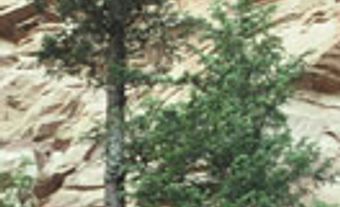Fir
Fir, Scandinavian for "pine," designates the "true" firs, which are evergreen conifers (genus Abies) of the pine family (Pinaceae). About 50 species occur worldwide, all in the Northern Hemisphere; 4 are native to Canada. Balsam fir (A. balsamea) occurs from Alberta to the Atlantic Provinces. Alpine fir (A. lasiocarpa) grows at high elevations in the West, from Alaska to Mexico. Pacific silver fir (A. amabilis) and grand fir (A. grandis) grow along the BC, Washington and Oregon coasts. Three introduced species (white, shasta and Spanish firs) are planted as ornamentals.
Firs have single straight trunks and narrow pyramidal crowns. Branches are regularly whorled; leaves are flat and needlelike. Cones are erect and usually restricted to upper branches. Pollination occurs in spring; seeds are mature in the fall. The bracts (modified leaves) and scales (ovule-bearing structures) are shed from the cone axis with the winged seeds.
Firs are stately trees, making them popular as Christmas trees. The first Christmas tree in North America was a fir lit with candles and gracing the dining room of the baroness Friederike von Riedesel in Sorel (now Sorel-Tracy), Québec, in 1781. The relatively light, soft, weak wood is used extensively for pulp, paper and lumber.

 Share on Facebook
Share on Facebook Share on X
Share on X Share by Email
Share by Email Share on Google Classroom
Share on Google Classroom


